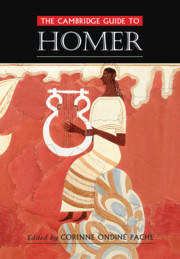Book contents
- The Cambridge Guide to Homer
- The Cambridge Guide to Homer
- Copyright page
- Contents
- Figures
- Notes on the Contributors
- General Introduction
- Part I Homeric Song and Text
- Part II Homeric World
- Introduction
- Homeric Communities
- Homeric Religion
- Homer and History
- Homeric Geography
- Homeric Materiality
- Key Topics
- Part III Homer in the World
- Bibliography
- Index
Introduction
from Part II - Homeric World
Published online by Cambridge University Press: 22 February 2020
- The Cambridge Guide to Homer
- The Cambridge Guide to Homer
- Copyright page
- Contents
- Figures
- Notes on the Contributors
- General Introduction
- Part I Homeric Song and Text
- Part II Homeric World
- Introduction
- Homeric Communities
- Homeric Religion
- Homer and History
- Homeric Geography
- Homeric Materiality
- Key Topics
- Part III Homer in the World
- Bibliography
- Index
Summary
The title of this part, “Homeric World,” is likely to bring up in most readers’ minds two different concepts of the types of worlds that these essays deal with. The first of course concerns the world within which the characters of the Homeric epics live and act – the heroes’ immediate landscape. The second is concerned with the actual historical time period in our own world with which the epics may be linked. Both of these worlds are discussed within the essays of this part of the book. To take the world of the heroes first, this Homeric world was created and recreated over and over again by the poets who related tales of the Trojan War and of Odysseus’s return to his home in Ithaca. The many layers of this Homeric world inspire us to delve deeply into the epics in order to further our understanding of the poems and the actions of the characters. We, the poems’ current audience, want to know more about the heroes and their motivations as we search for answers to perennial questions such as “What is the source of Achilles’ wrath?” and “Why would Odysseus choose to face eventual death at Penelope’s side rather than living forever with Calypso?”
- Type
- Chapter
- Information
- The Cambridge Guide to Homer , pp. 219 - 224Publisher: Cambridge University PressPrint publication year: 2020



